|
|
|
Sort Order |
|
|
|
Items / Page
|
|
|
|
|
|
|
| Srl | Item |
| 1 |
ID:
172613
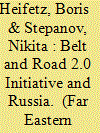

|
|
|
|
|
| Summary/Abstract |
This article analyzes the six-year period of implementation of the global Chinese project One Belt, One Road (OBOR), or the Belt and Road Initiative (BRI). Its positive aspects are highlighted: expanding the number of participants and their areas of interaction, creating a powerful financial base, creating new transborder transportation routes, increasing trade and investment among the countries participating in the project. Problems have been identified, including the lack of transparency of OBOR projects, insufficient consideration of national interests and local needs of China's partners, increasing their geopolitical risks, and the "debt trap" of Chinese loans. Possible ways of deepening the Russian-Chinese interaction at the new stage of BRI 2.0 development are proposed.
|
|
|
|
|
|
|
|
|
|
|
|
|
|
|
|
| 2 |
ID:
148688
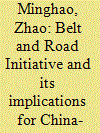

|
|
|
|
|
| Summary/Abstract |
The EU brought out a Global Strategy for foreign and security policy in June 2016, which indicates European efforts to reflect on and reshape its grand strategy. Meanwhile, China is also conducting an in-depth assessment of the international order under transition, and strives to rebalance its own national development and foreign policies. Beijing is pursuing a connectivity-oriented grand strategy. The peaceful rise of China depends on whether China and other economies can fully leverage each other’s development opportunities, and become stronger by taking advantage of increasing interconnectedness in the world. The One Belt, One Road (OBOR) initiative is a key element of such a grand strategy and will have far-reaching implications for China-Europe relations.
|
|
|
|
|
|
|
|
|
|
|
|
|
|
|
|
| 3 |
ID:
152274
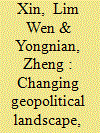

|
|
|
|
|
| Summary/Abstract |
As the world’s second-largest economy, China is set to gradually shape and reconstruct the international order. In 2013, the Chinese leadership announced the “One Belt, One Road” initiative as a strategic construct of Chinese peripheral influence and regional integration. As a great power, China needs to take the initiative to go beyond its responsibility as a “developing nation”. While China and the United States share many common interests and highly interdependent economic relations, a new world order is viable only with the cooperation of China and the United States.
|
|
|
|
|
|
|
|
|
|
|
|
|
|
|
|
| 4 |
ID:
145200
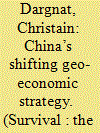

|
|
|
|
|
| Summary/Abstract |
Against an international backdrop of slowing global trade and the rise of the service industry over manufacturing, the Chinese economic model is approaching exhaustion. China is struggling to confront over-indebtedness, excess production capacity, declining competitiveness, unfavourable demographics and the flight of capital. In response, the Chinese government is adopting a change in geo-economic strategy, based on two major initiatives: a transformation of its domestic financial system, and the ‘One Belt, One Road’ (OBOR) project. The success of these initiatives will be vital to China’s economic development, political and social stability, and geopolitical emergence.
|
|
|
|
|
|
|
|
|
|
|
|
|
|
|
|
| 5 |
ID:
172626


|
|
|
|
|
| Summary/Abstract |
The upwards trajectory of China’s geopolitics in the beginning of 2018 has flattened in the beginning of 2019. This may be the result of the US trade war with China, hiccups in the Belt and Road initiative or the geopolitical churning in Asia. The article illuminates the geopolitical situation and the implications it has for India based upon the author’s travel to Chengdu and Tibet in 2018. The problems that China faces are seen in light of its internal dynamics and a prognosis made keeping in view developments in Tibet. With this background, the author looks at evolving Sino-Indian relations which include a yearning to enhance trade relations while being sceptic about growing strategic proximity between India and the US. The conclusive point made is that the Chinese look at the geopolitical issues purely from the prism of their core interests and seem to have hazy understanding of India’s core interests and concerns. India needs to bridge this gap. Both credible deterrence and deft diplomacy are required for this.
|
|
|
|
|
|
|
|
|
|
|
|
|
|
|
|
| 6 |
ID:
156570


|
|
|
|
|
| Summary/Abstract |
One Belt, One Road (OBOR) initiative of China is one of most ambitious foreign and economic policy in recent times which parallels that of the Marshal Plan of post-world war world order. It is the pet project of President Xi Jinping and aims to strengthen Beijing’s economic leadership through a vast program of infrastructure building throughout China’s neighbouring regions.
|
|
|
|
|
|
|
|
|
|
|
|
|
|
|
|
| 7 |
ID:
162809
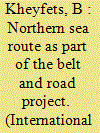

|
|
|
|
|
| Summary/Abstract |
The Northern Sea Route (NSR) may become a significant Russian contribution to China's One Belt, One Road project due to the shared interests of Russia and China. Russia definitely needs the NSR much more than any of the potential other participants in Belt and Road. The NSR plays a key role in the development of vast Russian territories that are largely uninhabited but possess tremendous reserves of timber, gas, oil and various other minerals and extensive sea areas with large fish resources. According to some estimates, the NSR connects areas that make up nearly 70% of Russia's territory.1 The NSR also has national security significance that is hard to overestimate. All this makes the NSR a strategic asset for Russia.
|
|
|
|
|
|
|
|
|
|
|
|
|
|
|
|
| 8 |
ID:
189295


|
|
|
|
|
| Summary/Abstract |
The implementation of regional transformation plans in Liaoning Province aims to establish a digital intelligent manufacturing center, a comprehensive regeneration zone in Northeast China, an international shipping center in Northeast Asia, and an offshore economic development cooperation zone. Particular attention is being paid to the system of interregional cooperation with Russian regions. The modern development of Liaoning Province in cooperation with regions of the world is based on the implementation of the New Silk Road (One Belt, One Road Initiative - OBOR) global project. Liaoning Province's geographical advantages, developed infrastructure, numerous ports (Jinzhou, Dandong, Dalian, Yingkou), and developed railroad network give it major advantages over other regions of China. The Chinese side is interested in bringing dialogue with fraternal regions of Russia from humanitarian cooperation to a system of multivector partnership interaction.
|
|
|
|
|
|
|
|
|
|
|
|
|
|
|
|
|
|
|
|
|